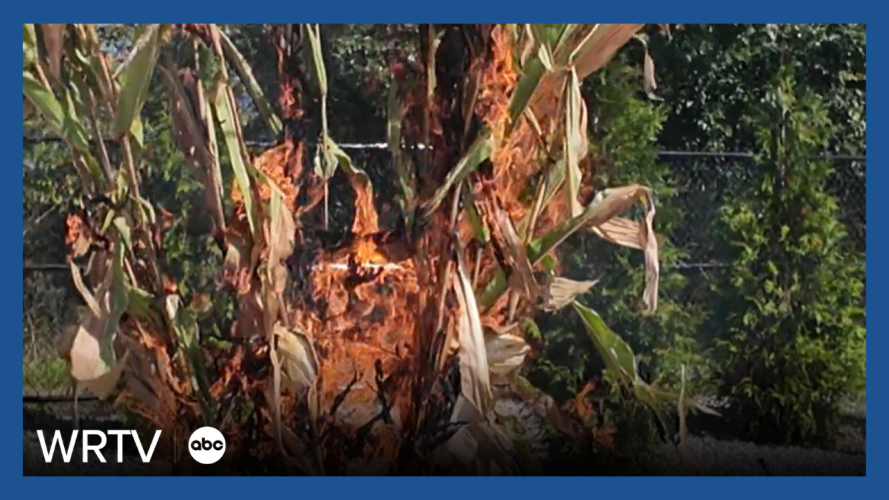DECATUR COUNTY — Fall means harvest, but with all the dry weather we’ve had recently, it can also mean elevated risk for field fires.
WATCH FOR FULL STORY BELOW:
Perhaps no one knows this better than John Hammersmith, who works as a Greensburg firefighter and helps on his family’s farm.
“They spend all year, they spend a lot of hard work, blood, sweat and tears,” Hammersmith said as he described of his family, “Making sure the crops grow to feed America. To see that go up in a matter of seconds in flames, that can be heartbreaking.”
Drought conditions have worsened across Indiana for the last two weeks in a row, despite the little bit of rain last week. Currently, 93% of the Hoosier state is in some form of drought.

The dry weather does mean that farmers have plenty of time to work their fields, but they have their guard up.
“We’ll slowly see that elevated risk for fires,” Hammersmith explained. “Brush fires really ramp up here in the next couple of weeks.”
The dry fields and dry forecast do not guarantee there will be a field fire, but firefighters and farmers are preparing in case they do get the call. Farmers can help mitigate risk by ensuring their machinery doesn’t spark or overheat.
“Us as firefighters will have to be ready to go at a moment’s notice,” Hammersmith explained.
To see just how quickly fires can spread through dry crops, I visited the Greensburg Fire Station.
Here, firefighters set up a small demonstration. They set a small cluster of cornstalks on fire. Within seconds, the entire cluster was engulfed in flames, and ash was shooting out into the surrounding area.
“When we measure fires, we measure it in seconds, because it can double in size every 20 to 30 seconds,” Hammersmith said. “So time really does matter.”
While the firefighters were able to easily put out this fire, putting out the real thing takes lots of time and attention from firefighters who are already busy.
Curtis Lewis, the Assistant Chief, explained that each shift typically responds to four to five calls each shift. Adding field or brush fires on top of this gives them even more work.
Lewis recalled a 2009 fire that required every department in the county to respond.
“We call it the County Line Fire just because it was up near the northern part of the county,” Lewis shared. “It was an all-day event. We were out there long enough; we had to have fuel trucks come out there to respond to the scene to fuel up our trucks.”
Lewis shared that during extensive field fires, they take several precautions to make sure firefighters don’t get overheated or overexhausted.
Currently, Lewis is going over training with his crew to make sure they remember what to do in case of a field fire emergency.
This comes none too soon, as they had a recent situation. It only takes a small spark that could potentially ignite an entire field.

“Throwing cigarettes out of your vehicle is a big thing,” Lewis said. “We’ve had one fire in the last two weeks caused due to that.”
What else can spark field fires?
“Burning trash on these very dry weather days and windy days,” continued Lewis.
While at the station, I also got to see the department’s brush truck. It is a normal-sized truck, not the typical firetruck you would imagine. This smaller size and big tires help it navigate easily across fields.
The truck also holds its own water and can suction water out of ponds or other water sources to refill, since there is likely little access to fire hydrants in the middle of the fields.
While there are no ways to totally prevent a fire, the firefighters hope you’ll take steps this fall to lower the risk.
“To get to see the firefighter side of it, and have family in the farming business, it really puts it into perspective of what field fires can do,” Hammersmith concluded.





